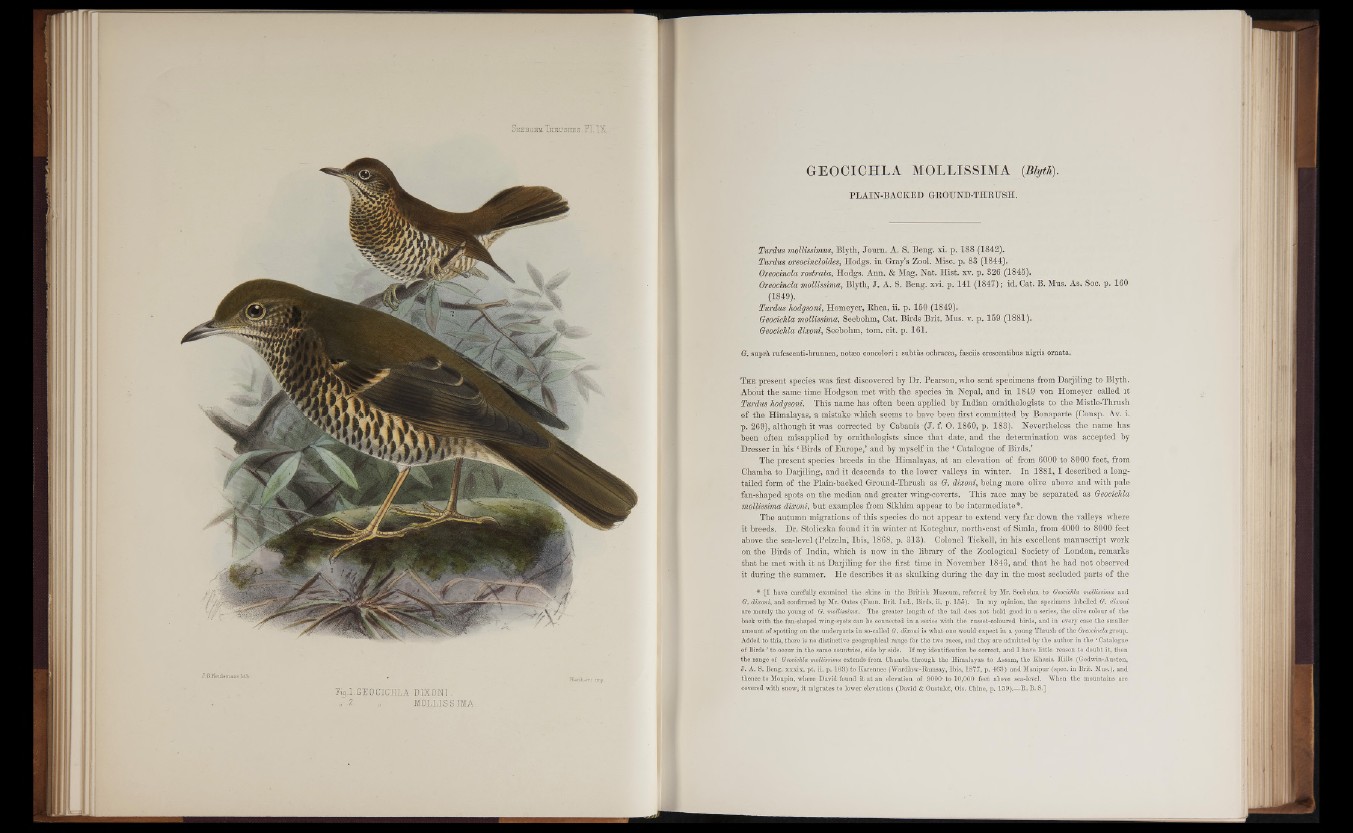
I%.1 GEOCICHLA DIXONI
I .2. | MOLLISSIMA
S e e b o h m Th r u s h e s . P I . I X .
PLAIN-BACKED GROUND-THRUSH.
Turdus mollissimus, Blyth, Joum. A. S. Beng. xi. p. 188 (1842).
Turdus oreocincloides, Hodgs. in Gray’s Zool. Misc. p. 83 (1844).
Oreocincla rostrata, Hodgs. Ann. & Mag. Nat. Hist. xv. p. 326 (1845),
Oreocincla mollissima, Blyth, J. A. S. Beng. xvi. p. 141 (1847); id. Cat. B. Mus. As. Soc. p. 160
(1849),
Turdus hodgsoni, Homeyer, Rhea, ii. p. 150 (1849).
Geocichla mollissima, Seebohm, Cat. Birds Brit. Mus. v. p. 159 (1881).
Geocichla dixoni, Seebohm, tom. cit. p. 161.
G. suprk rufeseenti-brunnea, noteeo concolori : subtus ochracea, fasciis crescentibus nigris ornata.
T he present species.was first discovered by Dr. Pearson, who sent specimens from Darjiling to Blyth.
About the same time Hodgson met with the species in Nepal, and in 1849 von Homeyer called it
Turdus hodgsoni. This name has often been applied by Indian ornithologists to the Mistle-Thrush
o f the Himalayas, a mistake which seems to have been first committed by Bonaparte (Consp. Av. i.
p. 269), although it was corrected by Cabanis (J. f. O. 1860, p. 183). Nevertheless the name has
been often misapplied by ornithologists since that date, and the determination was accepted by
Dresser in his * Birds of Europe,’ and by myself in the c Catalogue of Birds.’
The present species breeds in the Himalayas, at an elevation of from 6000 to 8000 feet, from
Chamba to Daijiling, and it descends to the lower valleys in winter. In 1 8 8 1 ,1 described a longtailed
form of the Plain-backed Ground-Thrush as G. dixoni, being more olive above and with pale
fan-shaped spots on the median and greater wing-coverts. This race may be separated as Geocichla
mollissima dixoni, but examples from Sikhim appear to be intermediate*.
The autumn migrations of this species do not appear to extend very far down the valleys where
it breeds. Dr. Stoliczka found it in winter at Koteghur, north-east of Simla, from 4000 to 8000 feet
above the sea-level (Pelzeln, Ibis, 1868, p. 313). Colonel Tickell, in his excellent manuscript work
on the Birds of India, which is now in the library of the Zoological Society of London, remarks
that he met with it at Daijiling for the first time in November 1843, and that he had not observed
it during the summer. He describes it as skulking during the day in the most secluded parts of the
* [I have carefully examined the skins in the British Museum, referred by Mr. Seebohm to Geocichla mollissima and
G. dixoni, and confirmed by Mr. Oates (Eaun. Brit. Ind., Birds, ii, p. 155). In my opinion, the specimens labelled G. dixoni
are merely the young of G. mollissima. The greater length of the tail does not hold good in a series, the olive colour of the
back with the fan-shaped wing-spots can be connected in a series with the russet-coloured birds,, and in every case the smaller
amount of spotting on the underparts in so-called G. dixoni is what one would expect in a young Thrush of the Oreocincla group.
Added to this, there is no distinctive geographical range for the two races, and they are admitted by the author in the ‘ Catalogue
of Birds ’ to occur in the same countries, side by side. If my identification be correct, and I have little reason to doubt it, then
the range of Geocichla mollissima extends from Chamba through the Himalayas to Assam, the Khasia Hills (Godwin-Austen,
J. A. S. Beng. xxxix. pt. ii. p. 103) to Karennee (Wardlaw-Bamsay, Ibis, 1877, p. 463) and Manipur (spec, in Brit. Mus.), and
thence to Moupin, where David found it at an elevation of 9000' to 10,000 feet above sea-level. When the mountains are
covered with snow, it migrates to lower elevations (David & Oustalet, Ois. Chine, p. 159).:—B.. B. S.]